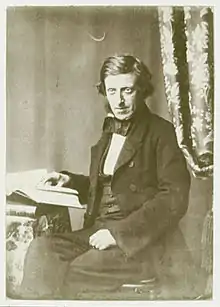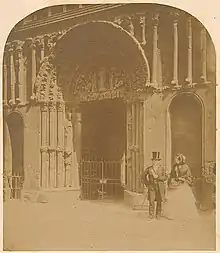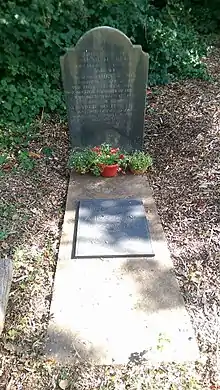Frederick Scott Archer | |
|---|---|
 Frederick Scott Archer – by Robert Cade, c. 1855 | |
| Born | 1813 |
| Died | 1 May 1857 (aged 43 or 44) |
| Resting place | Kensal Green Cemetery |
| Nationality | English |
| Occupation | sculptor |
| Known for | Collodion process |
.jpg.webp)
Frederick Scott Archer (1813 – 1 May 1857) was an English photographer and sculptor who is best known for having invented the photographic collodion process[1] which preceded the modern gelatin emulsion. He was born in either Bishop's Stortford or Hertford, within the county of Hertfordshire, England (United Kingdom of Great Britain and Ireland) and is remembered mainly for this single achievement which greatly increased the accessibility of photography for the general public.
Life
Scott Archer was the second son of a butcher in Bishops Stortford in Hertfordshire who went to London to take an apprenticeship as a goldsmith and silversmith with a Mr Massey of 116 Leadenhall Street.[2]
On the recommendation of Edward Hawkins he trained at the Royal Academy Schools as a sculptor and found calotype photography useful as a way of capturing images of his sculptures. Dissatisfied with the poor definition and contrast of the calotype and the long exposures needed, Scott Archer invented the new process in 1848 and published it in The Chemist in March 1851, enabling photographers to combine the fine detail of the daguerreotype with the ability to print multiple paper copies like the calotype.[3] In publishing his discovery, he did so knowingly without first patenting it,[3] giving it as a gift to the world.[4]
As a sculptor he exhibited at the Royal Academy from 1836 until 1851.
He died impoverished, as since he did not patent the collodion process he made very little money from it.[3] An obituary described him as "a very inconspicuous gentleman, in poor health."
His family received a gift of £747 after his death, raised by public subscription, and a small pension was also provided to support his three children after the death of their mother.[3]
The Royal Photographic Society has a small collection of Scott Archer's photographs; some are also held in the Victoria and Albert Museum.
Archer died on 1 May 1857 of a hereditary cystic disease of the liver which had plagued him for his last 11 weeks and is buried at Kensal Green Cemetery in London.
Known Sculptures
- Bust of the Sir George Smart (1839)
- Statue of Alfred the Great with he Book of Common Law (1844), Westminster Hall
- Bust of Dean of Manchester (1848)
- Memorial to Lady Albert Conyngham (1850) in Mickleham Church
- Bust of he Marquess of Northampton (1850)
- Statue of Gertrude Hanson (1851)
Collection
- International Photography Hall of Fame, St.Louis, Missouri[5]
 Frederick Scott Archer (1813–1856), Rochester Cathedral, England, early 1850s, albumen print from wet plate collodion negative, Department of Image Collections, National Gallery of Art Library, Washington, DC
Frederick Scott Archer (1813–1856), Rochester Cathedral, England, early 1850s, albumen print from wet plate collodion negative, Department of Image Collections, National Gallery of Art Library, Washington, DC
See also
References
- ↑ Phil Coomes (27 April 2010). "Remembering Frederick Scott Archer". BBC. Retrieved 6 December 2010.
- ↑ Dictionary of British Sculptors 1660-1851 by Rupert Gunnis
- 1 2 3 4 "Frederick Scott Archer". British Journal of Photography. 22 (773): 102–104. 26 February 1875.
- ↑ Peres, Michael R., ed. (2007). Focal Encyclopedia of Photography: Digital Imaging, Theory and Applications. Focal Press. p. 124. ISBN 978-0-240-80740-9.
- ↑ "Frederick Scott Archer". International Photography Hall of Fame. Retrieved 19 February 2020.
External links
- Isleworth with natural clouds at The Royal Collection Trust
- "Archer, Frederick Scott" on Oxford Dictionary of National Biography
- "Frederick Scott Archer" on The Oxford Companion to the Photograph
- "Frederick Scott Archer" on The International Photography Hall of Fame and Museum
- "Frederick Scott Archer" at The J. Paul Getty Trust
